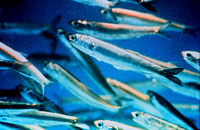Anchovy
| Anchovies | ||||||||||
|---|---|---|---|---|---|---|---|---|---|---|
 | ||||||||||
| Scientific classification | ||||||||||
| ||||||||||
|
Amazonsprattus |
The anchovies are a family (Engraulidae) of small but common salty fish. They are found in scattered areas throughout the world's oceans, but are concentrated in temperate waters, and are rare or absent in very cold or very warm seas.
Biology
The anchovy is a small green fish with blue reflections due to a silver longitudinal stripe that runs from the base of the caudal fin. It is maximum nine inches (~23 cm) in length and body shape is variable with more slender fish in northern populations. The snout is blunt with small, sharp teeth in both jaws. The mouth is larger than those of herrings and silversides, two fish which they closely resemble. It eats plankton and fish larvae.
It is generally very accepting of a wide range of temperatures and salinity. Large schools can be found in shallow, brackish areas with muddy bottoms, as in estuaries and bays.
Spawning occurs between October and March, but not in water colder than 12 °C. The anchovy appears to spawn at least 100 kilometers from the shore, near the surface of the water.
Habitat
Anchovies are abundant in the Mediterranean, and are regularly caught on the coasts of Sicily, Italy, France and Spain. The range of the species also extends along the Atlantic coast of Europe to the south of Norway.
As a food source
The anchovy is a good food source for almost every predatory fish in its environment, including the California halibut, rock fish, yellowtail, sharks, chinook, and coho salmon. It is also extremely important to marine mammals and birds; for example, California brown pelicans and elegant terns, whose breeding success is strongly connected to anchovy abundance. As time progresses and the anchovy population drops, the population of the predatory species is also expected to decline[citation needed].
Anchovies are also eaten by humans. Preserved by being gutted and salted in brine, matured, then packed in oil, they are an important food fish, both popular and infamous for their strong flavor. In Roman times, they were the base for the fermented fish sauce called garum that was a staple of cuisine and an item of long-distance commerce produced in industrial quantities. Today they are a key ingredient in Caesar salad and Spaghetti alla Puttanesca, and are occasionally used as a pizza topping. Because of the strong flavor they are also an ingredient in several sauces, including Worcestershire sauce and many fish sauces, and in some versions of Café de Paris butter. They are most commonly marketed in small tins, either as "flat" filets, or as "rolled anchovies" where each fillet is rolled around a caper. While both are quite salty, the flat fillets tend to be more so. They are also marketed in jars and tubes as a paste, mostly for use in making sauces, such as anchovy essence. Fishermen also use anchovies as bait for larger fish such as tuna and sea bass.
The strong taste that people associate with anchovies is due to the curing process. Fresh anchovies, known in Italy as alici, have a much softer and gentler flavor. In English-speaking countries, alici are sometimes called "white anchovies", and are often served in a weak vinegar marinade. This particular preservation method is associated with the coastal town of Collioure in south east France. The white fillets (a little like marinated herrings) are sold in heavy salt, or the more popular garlic or tomato oil and vinegar marinade packs.
The European anchovy, Engraulis encrasicolus, is the anchovy of commerce. Morocco now leads the world in canned anchovies. The anchovy industry along the coast of Cantabria now dwarfs the traditional Catalan salters, though the industry was only initiated in Cantabria by Sicilian salters in the mid 19th century.
Setipinna taty or ikan bilis is the anchovy commonly used in South-East Asian cooking to make fish stock or sambals. Anchovy is also used to produce budu, by fermentation process. In Vietnam, anchovy is the main ingredient to make fish sauce- nước mắm- the unofficial national sauce of Vietnam.
Anchovies can concentrate domoic acid which causes amnesic shellfish poisoning.
Fishing
Overfishing of anchovies has been a problem. Since the 1980s, large mechanized anchovy fishing vessels based in France have caught the fish in fine-mesh dragnets.
ReferencesISBN links support NWE through referral fees
- "Engraulidae". FishBase. Ed. Ranier Froese and Daniel Pauly. January 2006 version. N.p.: FishBase, 2006.
- Fisheries.vims.edu
- PSMFC.org
This article incorporates text from the Encyclopædia Britannica Eleventh Edition, a publication now in the public domain.
Credits
New World Encyclopedia writers and editors rewrote and completed the Wikipedia article in accordance with New World Encyclopedia standards. This article abides by terms of the Creative Commons CC-by-sa 3.0 License (CC-by-sa), which may be used and disseminated with proper attribution. Credit is due under the terms of this license that can reference both the New World Encyclopedia contributors and the selfless volunteer contributors of the Wikimedia Foundation. To cite this article click here for a list of acceptable citing formats.The history of earlier contributions by wikipedians is accessible to researchers here:
The history of this article since it was imported to New World Encyclopedia:
Note: Some restrictions may apply to use of individual images which are separately licensed.
